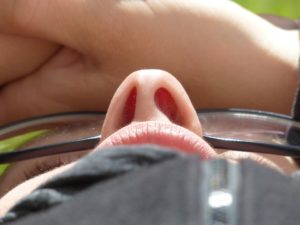This post is part of a series of guest posts on GPS by the graduate students in my Psychopathology course. As part of their work for the course, each student had to demonstrate mastery of the skill of “Educating the Public about Mental Health.” To that end, each student has to prepare two 1,000ish word posts on a particular class of mental disorders.
______________________________________________
A Brief History of Sleeping Disorders by Yasmin Shirali
The importance of sleep has been known to humans for many centuries. Historical references make it evident that sleep has always been considered crucial to survival. The importance of sleep is emphasized in many ancient texts, such as the Babylonian Talmud and the Bible. But with the mention of sleep also comes the mention of sleep problems. Evidence of sleep disorders is plentiful in historical works; there are many references to problems with sleep, particularly of insomnia. There are even references from the 1600s to certain sleep disturbances that would now classify as narcolepsy. Knowledge on sleep disorders is extremely valuable, as problems with sleep can lead to very serious consequences. We cannot survive without sleep. Anything that disrupts sleep is a potential killer of which we must be aware. Sleep disorders are not new, but the technology we have now is, and so new information is being collected everyday on potential causes and treatments for sleep disorders.
 Sleep disorders are changes or disruptions in sleep patterns that negatively impact a person’s ability to function. Suffering from impaired sleep can lead one to feel fatigued and unaware. The risk for accidents and injuries increases when suffering from a sleep disorder. The consequences of poor sleep can lead to poor health and even death. Research on sleep has been conducted since at least the late 1800s. Scientific sleep research began when Richard Caton successfully recorded the electrical brain activity of small animals. This achievement paved the way for discovering alpha waves in the human brain, which helped identify the stages of sleep. Only two years after Caton’s contributions, narcolepsy was first described in the medical literature. The 20th century saw a boom in sleep research, which led to the classification of many sleep disorders.
Sleep disorders are changes or disruptions in sleep patterns that negatively impact a person’s ability to function. Suffering from impaired sleep can lead one to feel fatigued and unaware. The risk for accidents and injuries increases when suffering from a sleep disorder. The consequences of poor sleep can lead to poor health and even death. Research on sleep has been conducted since at least the late 1800s. Scientific sleep research began when Richard Caton successfully recorded the electrical brain activity of small animals. This achievement paved the way for discovering alpha waves in the human brain, which helped identify the stages of sleep. Only two years after Caton’s contributions, narcolepsy was first described in the medical literature. The 20th century saw a boom in sleep research, which led to the classification of many sleep disorders.
Insomnia is the most commonly reported sleep disorder in the world. It involves either the difficulty of falling asleep, staying asleep, or not getting good sleep. Insomnia affects about 30% of adults at some point in life and is usually temporary. The point at which insomnia was first mentioned in the past is unclear, as insomnia is just a sleeping problem to put it simply. Any disruption in sleep or any sleep disturbance mentioned in history could be talking about insomnia. There are endless references to the inability to fall and stay asleep in historical texts. It is safe to assume that our ancestors knew about the struggles of insomnia.
Narcolepsy is characterized by the inability to control sleep/wake cycles, with intense sleepiness spells during the day, and sometimes accompanied with muscle weakness. Mentions of narcolepsy-like symptoms have occurred since the 15th century, however, it was not until the 20th century that scientific evidence revealed more about this disorder. The explosion of sleep research during this time made it possible to officially distinguish narcolepsy from other conditions such as epilepsy. Narcolepsy was even found to be present in canines in the 1970s.
In 1937, Alfred Loomis discovered non-REM sleep. Through his discoveries, he was able to describe the different stages of sleep. This allowed for deeper insight into how the brain functions during sleep. Many sleep disorders can look the same from the outside. Most complaints are simply feeling tired and not being able to sleep well. When you get a look inside however, you can begin to see that there are many different reasons for impaired sleep. Non-REM sleep arousal disorders include sleep walking and night terrors. Sleepwalking involves rising from bed during the first third of sleep. People can engage in different activities while sleepwalking and have no recollection of it when they awake. Sleep terrors are states of abrupt physiological arousal that awaken the person in fear in response to a nightmare-like dream. Usually these dreams are more intense and realistic than regular nightmares. REM disorder was officially described in 1986. REM sleep disorder is characterized by the absence of paralysis during REM sleep. As a consequence, suffers of REM sleep disorder act out their dreams, which can be very dangerous.
Restless leg syndrome (RLS) is a neurological disorder characterized by the intense desire to move one’s body. The desire is irresistible and one must keep moving his body to avoid unpleasant sensations. This leads to very fragmented sleep. The first medical description of RLS was in 1672 by Sir Thomas Willis in the De Anima Brutorum. There have been many references to RLS in old publications which is an indication that there were many sufferers in history.
The book “Le probleme physiologique du sommeil,” by French Scientist Henri Pieron was published in 1913, and is considered the first text to look at sleep physiologically. This text is regarded as the beginning of the modern approach to sleep research, which focuses on physiology. It is fascinating to learn how modern sleep research actually is. There is still a lot of unknown information that remains a mystery to scientists.
It is clear that sleep disorders have been around for at least as long as we have documented history. It is relatively safe to assume that sleep disorders have been around for as long as sleep has been around. The fact that even animals can suffer from sleep disorders (i.e., narcoleptic dogs) is evidence that sleep disorders occur in more than one species, likely many.
 Sleep disorders are extremely maladaptive and affect many people in very negative ways. So why are they still around? If sleep disorders were so maladaptive, then they should have been selected against in the past. The problem is that sleep disorders are not typically present during a person’s whole life. Many sleep disorders are temporary and come about after the age of reproduction. This makes it possible to pass down any genetic components contributing to sleep disorders to offspring. Another possibility is that many sleep disorders are severely worsened by stress that our ancestors may not have experienced. Sleep disorders may not have been as severe in the past and consequently, not so maladaptive. It is likely that as long as there has been sleep, there have been sleep disorders. Because of variability in time of onset, duration, and severity, it would be extremely rare for sleep disorders to be selected out of our species. Sleep disorders have a long history and—unfortunately—will likely have a long future.
Sleep disorders are extremely maladaptive and affect many people in very negative ways. So why are they still around? If sleep disorders were so maladaptive, then they should have been selected against in the past. The problem is that sleep disorders are not typically present during a person’s whole life. Many sleep disorders are temporary and come about after the age of reproduction. This makes it possible to pass down any genetic components contributing to sleep disorders to offspring. Another possibility is that many sleep disorders are severely worsened by stress that our ancestors may not have experienced. Sleep disorders may not have been as severe in the past and consequently, not so maladaptive. It is likely that as long as there has been sleep, there have been sleep disorders. Because of variability in time of onset, duration, and severity, it would be extremely rare for sleep disorders to be selected out of our species. Sleep disorders have a long history and—unfortunately—will likely have a long future.
